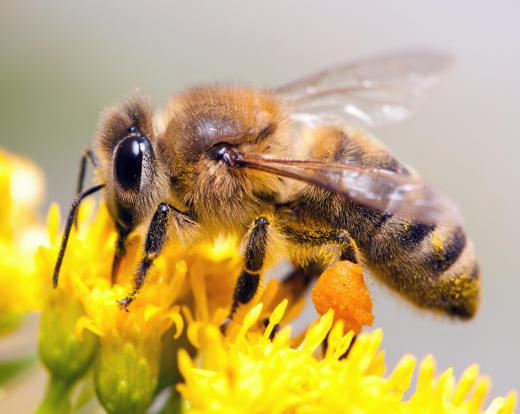What is a Conditioned Response?
A conditioned response is a type of learned behavior, and is often considered one of the simplest. It is a response that is obtained through a stimulus other than the one that originated it. Such a response also is often called a conditioned reflex.
Conditioned response can be developed through a procedure called acquisition which involves pairing a neutral stimulus with the conditioned one. One common example is when the loud ringing a bell produces scares animals. Pairing another more neutral stimulus with the bell, such as a particular dog toy, typically causes the animal to associate the loud sound with the toy. The animal eventually will be scared upon the appearance of the toy itself without the bell having to ring.

Classical conditioning, of which a conditioned response is a large part, was developed by Ivan Pavlov in the early 1900s. Pavlov's experiment involved dogs in which he noticed that the dogs developed a habit of salivating in response to the lab technician that fed them their meat powder rather than to the food itself. To test his theory, Pavlov used a metronome to signal it was time to eat, and after a few times, the dogs began to salivate upon hearing the click of the device.

It is helpful to know the other elements in classical conditioning to fully understand a conditioned response. An unconditioned stimulus is one that naturally triggers a response in either humans or animals, such as the smell of food. The unconditioned response of hunger is natural. By contrast, a conditioned stimulus was at one time neutral, but when it is paired with the unconditioned stimulus, it becomes associated and will obtain the same response, which is the conditioned response.

Conditioned response theory has been helpful in studying the sensory abilities of various animals. For example, Karl von Frisch was able to determine that honeybees can see several colors by conditioning them to look for food on blue cardboard. Once they showed the proper response, he did the same with cardboard in other colors and discovered that bees can tell the difference between blue and green, blue and violet, and yellow and green.

Though this type of response is often associated with animals, it can also figure into the daily lives of people. Children first learn to associate the word, "No!" with an angry face, and eventually learn to stop their behavior. Most conditioned responses, especially those learned at an early age, become permanently ingrained.
AS FEATURED ON:
AS FEATURED ON:















Discussion Comments
@SurfNTurf - Good for you. It is hard to overcome phobias like that and I am sure that over time you will be able to conquer it.
I wanted to add that operant conditioning is very common among parents and teachers alike. Often teachers will give special prizes to children that complete their work accurately. For example, my son’s teachers gives all of the children a sticker book and once they complete their accelerated reader goal they not only get a sticker in their book, but once the entire class meets the goal they get a non-uniform day so that they could wear their favorite outfits.
My daughter’s teacher uses operant conditioning with respect to behavior as well. The children are given a color coded system and if they reach the second level of the color coded system due to misbehavior, then they do not have access to the goody bag at the end of the week.
This keeps the children behaving better and it gives them something to look forward to at the end of the week. It is a really good idea.
@Bhutan - I know what you mean. I love the smell of bread when it is coming out of the oven. I wanted to add that I usually have a conditioned fear response when waiting in line to ride a roller coaster or a ride that involves dramatic heights.
I have a fear of heights and when I enter a line to ride one of these types of rides I start to swallow more and begin to breathe heavily. My palms also get sweaty and I start to develop a little bit of anxiety as I approach the seat.
When the ride is over, I am totally relived and the feeling goes away. I am getting better. I would never be able to go near a ride that went really high in the sky, but little by little my conditional emotional response is lessening.
I always have a conditioned response of having my mouth water whenever I enter a bakery. It is the smell of freshly baked bread and pastries that really instantly makes me want to eat everything in sight.
It is conditional response because I could be perfectly satisfied and not feeling hungry, but the smell automatically makes me crave the food.
I believe that while conditioned responses in humans are natural and help us to navigate our world, I also believe that there are certain industries that use this knowledge against us.
In the case of gambling, one of the worst examples of a conditioned response is how people react when playing the slots. You can follow a person's anxiety, tension and relief, then joy, by just watching the spinning of the reels.
People in casinos are conditioned to respond to bright lights and loud sounds as a mechanism of reward. It's rather disturbing to watch.
Can anyone think of any other ways that humans have had a conditioned response used to train them for a behavior that isn't entirely beneficial?
Spotting conditioned responses within yourself is an interesting task. Just go throughout your day and see which objects and sensations trigger what feelings and responses.
A good example of this is getting a letter in the mail from a loved one and automatically feeling a rush of happiness or warmth from reading their name on the letter. This has been conditioned into you from previous exposure to that individual, so that you now automatically respond to their name with certain conditioned feelings.
It really is interesting to find out how many of our daily interactions with people have been conditioned into us.
Conditioned response examples in humans are not always based on negative experiences. The Pavlovian model can also apply to things like advertising.
Studies show that beautiful women are often used to sell products and services because both genders associate the product with positive feelings afterwards.
@Esther11- The principal of conditioned response works very strongly in humans as well as animals. Even in everyday life one can witness small children automatically responding to certain triggers. Children who have been traumatized, for example, by abuse, may associate a cologne or perfume worn by the abuser with fear, and whenever they smell that cologne or perfume will experience fear, even into adulthood.
@Esther11 - There are lots of human behaviors that are learned by conditioned response. There are many primary behaviors that young children learn by conditioned response. A child might hear the word "no" and not pay any attention to it. Then he notices that a parent's angry face goes with the "no." Eventually he learns that just the "no" alone means "stop your behavior."
Another example is a conditioned fear response. You may have had a bad experience at the dentist. You remember that experience. So, every time you drive past a dentist office, see a dental ad on TV or in a magazine, you automatically feel the anxiety you felt at the dentist's office. If this response comes often enough, it could develop into a phobia.
I have heard a lot about animals, mainly dogs and cats,being subjects to condition response, like being excited by the sound of the can opener being opened. Then the opening of the can is joined by his food being served. Then just the sight of the can excites him.
i would like to know how this principle of conditioned response works in people?
Post your comments